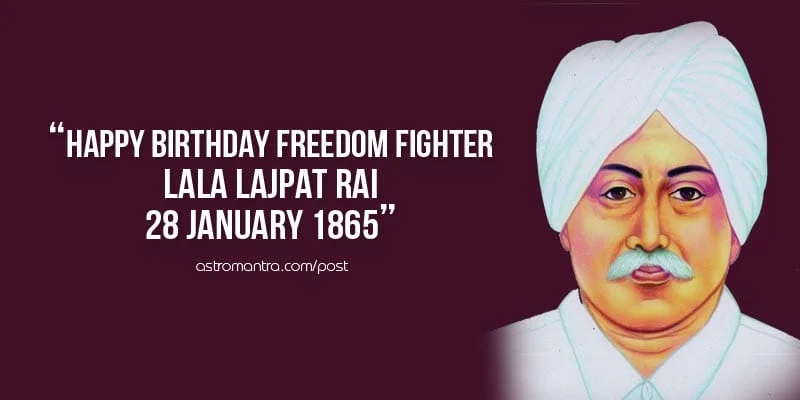Lala Lajpat Rai Biography

Lala Lajpat Rai Biography(लाला लाजपत राय): Lala Lajpat Rai pronunciation, (28 January 1865–17 November 1928) was an Indian freedom fighter. He was popularly known as Punjab Kesari. He was one third of the Lal Bal Pal triumvirate. Lala Lajpat Rai (Lala Lajpat Rai Biography) was a prominent nationalist leader who played an important role in India’s struggle for freedom. He was a prominent member of the famous ‘Lal Bal Pal’ firebrand trio during the independence movement. His fierce brand of patriotism and potent vocalism against the British rule earned him the title of ‘Punjab Kesari’ or the Lion of the Punjab.
He also initiated the foundation of Punjab National Bank. In 1897, he founded the Hindu Orphan Relief Movement to keep the Christian missions from securing custody of these children. He was badly injured in police lathi-charge on the activists, who were protesting the arrival of Simon Commission, and died a few days later due to the injuries. Lala Lajpat Rai(Lala Lajpat Rai Biography) was born on January 28, 1865 to Munshi Radha Krishna Azad and Gulab Devi at Dhudike village in Ferozpur District. Munshi Azad was a scholar of Persian and Urdu. Lala’s mother was a religious lady who inculcated strong moral values in her children.
His family values allowed Lajpat Rai(Lala Lajpat Rai Biography) the freedom of having different faiths and beliefs. He received his elementary education in the Government Higher Secondary School, Rewari where his father was posted as teacher. Lajpat Rai(Lala Lajpat Rai Biography) joined the Government College at Lahore in 1880 to study Law. While in college he came in contact with patriots and future freedom fighters like Lala Hans Raj and Pandit Guru Dutt. He studied law from Government College in Lahore and thereafter started his legal practice in Hissar, Haryana. Since childhood he had a desire to serve his country and therefore took a pledge to free it from foreign rule.
In 1884 his father was transferred to Rohtak and Lala Lajpat Rai(Lala Lajpat Rai Biography) came along. He married Radha Devi in 1877. In 1886 the family shifted to Hissar, where he practiced law. During the 1888 and 1889 annual sessions of the National Congress, he participated as a delegate. He moved to Lahore to practice before the High Court in 1892. Lala Lajpat Rai(Lala Lajpat Rai Biography) was a voracious reader and everything he read left a great imprint on his mind. He was deeply impressed by the ideals of patriotism and nationalism outlined by Italian revolutionary leader Giuseppe Mazzini.
Inspired by Mazzini, Lala ji(Lala Lajpat Rai Biography) became indoctrinated into the revolutionary way of attaining freedom. He, together with other prominent leaders like Bipin Chandra Pal, Aurobindo Ghosh from Bengal, and Bal Gangadhar Tilak from Maharashtra, began to see the negative aspects of moderate politics advocated by many leaders of the Indian National Congress. They voiced their strong opposition to the Congress’ demand for gradual progress to dominion status and began voicing the need for complete independence or ‘Purna Swaraj’.
In personal views he was a great believer in inter-faith harmony, but he did not think right of the trend by Congress leaders to sacrifice Hindu interests to appease the Muslim section of the party. Lala(Lala Lajpat Rai Biography) was one of the few leaders who realized the difficulties of a united anti-colonial struggle and a possible source of religious conflict between the Hindus and Muslims of the country. His proposal for “a clear partition of India into a Muslim India and non-Muslim India” on December14, 1923, in The Tribune, met with major controversy. On October 30, 1928, Lala Lajpat Rai led a peaceful procession to oppose the arrival of the Simon Commission in Lahore.
Intercepting the march, Superintendent of Police, James A. Scott ordered his police force to ‘lathi-charge’ at the activists. The police targeted Lajpat Rai(Lala Lajpat Rai Biography), in particular, and hit him on the chest. This action left Lala Lajpat Rai with severe injuries. He died of a heart attack on November 17, 1928. His followers squarely placed the blame on the British and vowed to avenge his death. Chandrasekhar Azad along with Bhagat Singh and other associates plotted the assassination of Scott but the revolutionaries shot J.P. Saunders, mistaking him as Scott.
Lala Lajpat Rai(Lala Lajpat Rai Biography) made lasting impression in the minds of his countrymen not only by his leadership abilities, but made his presence felt in fields of education, commerce and even healthcare. He was a follower of Dayanand Saraswati and helped establish the nationalistic Dayanand Anglo-Vedic School. He initiated the established of a bank which later evolved as the ‘Punjab National Bank’. He established a trust in his mother Gulabi Devi’s name in 1927 and oversaw the opening of a tuberculosis hospital for women named Gulabi Devi Chest Hospital.
लाला लाजपत राय जीवन परिचय | Lala Lajpat Rai Biography
लाला लाजपत राय का जन्म 28 जनवरी, 1865 को पंजाब के मोगा में एक साधारण परिवार में हुआ था। उनके पिता लाला राधाकृष्ण एक अध्यापक रहे। इसका प्रभाव लाजपत राय पर भी पड़ा। शुरूआती दिनों से ही वे एक मेधावी छात्र रहे और अपनी स्कूली शिक्षा पूरी करने के बाद वकालत की ओर रुख कर लिया। वे एक बेहतरीन वकील बने और कुछ समय तक वकालत भी की लेकिन जल्दी ही उनका मन इस काम से उचट गया। अंग्रेजों की न्याय व्यवस्था के प्रति उनके मन में रोष पैदा हो गया। उन्होंने उस व्यवस्था को छोड़कर बैंकिंग का रूख किया। उन्होंने अपनी आजीविका चलाने के लिए बैंकिंग का नवाचार किया। उस समय तक भारत में बैंक कोई बहुत अधिक लोकप्रिय नहीं थे लेकिन उन्होंने इसे चुनौती की तरह लिया और पंजाब नेशनल बैंक तथा लक्ष्मी बीमा कंपनी की स्थापना की।
दूसरी तरफ वे लगातार कांग्रेस के माध्यम से अंग्रेजों की खिलाफत करते रहे। अपनी निर्भिकता और गरम स्वभाव के कारण इन्हें पंजाब केसरी के उपाधी से नवाजा गया। बाल गंगाधर तिलक के बाद वे उन शुरूआती नेताओं में से थे जिन्होंने पूर्ण स्वराज की मांग की। पंजाब में वे सबसे लोकप्रिय नेता बन कर उभरे। आजादी के प्रखर सेनानी होने के साथ ही लाला जी का झुकाव भारत में तेजी से फैल रहे आर्य समाज आंदोलन की तरफ भी था। इसका परिणाम हुआ कि उन्होंने जल्दी ही महर्षि दयानंद सरस्वती के साथ मिलकर इस आंदोलन का आगे बढ़ाने का काम हाथ में ले लिया। आर्य समाज भारतीय हिंदू समाज में फैली कूरीतियों और धार्मिक अंधविश्वासों पर प्रहार करता था और वेदों की ओर लौटने का आवाहन करता था। लाला जी ने उस वक्त लोकप्रिय जनमानस के विरूद्ध खड़े होने का साहस किया।
ये उस दौर की बात है जब आर्य समाजियों को धर्मविरोधी समझा जाता था, लेकिन लाला जी ने इसकी कतई परवाह नहीं की। जल्दी ही उनके प्रयासों से आर्य समाज पंजाब में लोकप्रिय हो गया। भारतीय राष्ट्रीय कांग्रेस से जुड़ना लाला जी के जीवन की सबसे महत्वपूर्ण घटना थी । 1888 में कांग्रेस का वार्षिक अधिवेशन इलाहाबाद में हुआ और यह पहला अवसर था जब लाला लाजपत राय को इस संगठन से जुड़ने का अवसर मिला । अपने शुरूआती दिनों में ही उन्होंने एक उत्साही कार्यकर्ता के तौर पर कांग्रेस में पहचान बनानी शुरू कर दी। धीरे—धीरे वे कांग्रेस के पंजाब प्रांत के सर्वमान्य प्रतिनिधि मान लिए गए। भारत की आजादी की लड़ाई एक बड़ा वाकया उस वक्त घटित हुआ, जब भारतीयों से बात करने आए साइमन कमीशन का विरोध का फैसला गांधी द्वारा लिया गया। साइमन कमीशन जहां भी गया, वहां साइमन गो बैक के नारे बुलंद हुए।
30 अक्टूबर 1928 को जब कमीशन लाहौर पहुंचा तो लाला लाजपत राय के नेतृत्व में एक दल शांतिपूर्वक साइमन गो बैक के नारे लगाता हुआ अपना विरोध दर्ज करवा रहा था। तभी अंग्रेज पुलिस ने उन पर लाठीचार्ज कर दिया और एक युवा अंग्रेज अफसर ने लालाजी के सर पर जोरदार प्रहार किया। लाला लाजपत राय जी का कथन था— मेरे शरीर पर पड़ी एक—एक लाठी ब्रिटिश साम्राज्य के ताबूत में कील का काम करेगी। सिर पर लगी हुई चोट ने लाला लाजपत राय का प्राणान्त कर दिया। उनकी मृत्यु से पूरा देश भड़क उठा। इसी क्रोध के परिणामस्वरूप भगतसिंह, राजगुरू और सुखदेव ने अंग्रेज पुलिस अधिकारी सांडर्स की हत्या की और फांसी के फंदे से झूल गए। लाला लाजपत राय भारतीय स्वतंत्रता संग्राम के उन सेनानियों में से एक रहे जिन्होंने अपना सबकुछ देश को दे दिया। उनका जीवन ढेर सारे कष्टों और संघर्ष की महागाथा है, जिसे आने वाली पीढ़ीया युगों तक कहती—सुनती रहेंगी।


